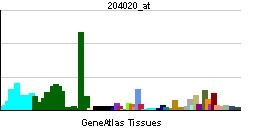Entrez 5813 | Ensembl ENSG00000185129 | |
 | ||
Aliases PURA, PUR-ALPHA, PUR1, PURALPHA, MRD31, purine-rich element binding protein A, purine rich element binding protein A External IDs MGI: 103079 HomoloGene: 4279 GeneCards: PURA | ||
Transcriptional activator protein Pur-alpha is a protein that in humans is encoded by the PURA gene.
Contents
Gene
PURA is located on chromosome 5 at 5q31.2 and is encoded by a single exon that encodes a highly conserved multifunctional protein, Purα (Pur-alpha). PURA is expressed ubiquitously, including the brain, muscle, heart, and blood.
Function
Transcriptional activator protein Pur-alpha is a sequence-specific, single-stranded DNA-binding protein. It binds preferentially to the single strand of the purine-rich element termed PUR, which is present at origins of replication and in gene flanking regions in a variety of eukaryotes from yeasts through humans. Thus, it is implicated in the control of both DNA replication and transcription.
The Pur-alpha protein is very highly conserved, with regulatory roles in DNA replication, gene transcription and RNA transport. It is involved in neuronal proliferation, dendrite maturation, and the transport of mRNA to translation sites during neuronal development.
Structure
Purα is a member of the Pur family of nucleic acid binding proteins which consist of a glycine-rich flexible amino terminus, a central core region and a potential carboxy-terminal protein binding region. Other family member include PURB and PURG. All human Pur proteins have three sequence-specific repeats, Pur repeats I–III.
Clinical significance
Deletion of the PURA gene has been associated with myelodysplastic syndrome and acute myelogenous leukemia. Mutations in PURA may alter normal brain development and impair neuronal function, causing a condition being known as PURA Syndrome.
PURA is a candidate gene responsible for the developmental phenotype in the 5q31.3 microdeletion syndrome. However recently, a separate condition called PURA Syndrome has been identified. De novo mutations in PURA have been reported in 21 individuals. Patients were identified by clinical whole-exome sequencing (WES). All mutations are heterozygous, with a similar phenotype of hypotonia, developmental delay, movement disorder and seizures / seizure like movements.
Protein interactions
PURA has been shown to interact with E2F1.
